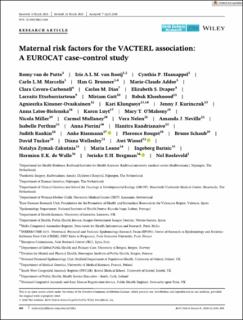Maternal risk factors for the VACTERL association: A EUROCAT case-control study
| dc.contributor.author | van de Putte, Romy | |
| dc.contributor.author | van Rooij, Iris A.L.M. | |
| dc.contributor.author | Haanappel, Cynthia P. | |
| dc.contributor.author | Marcelis, Carlo L.M. | |
| dc.contributor.author | Brunner, Han G. | |
| dc.contributor.author | Addor, Marie-Claude | |
| dc.contributor.author | Cavero-Carbonell, Clara | |
| dc.contributor.author | Dias, Carlos Matias | |
| dc.contributor.author | Draper, Elizabeth S. | |
| dc.contributor.author | Etxebarriarteun, Larraitz | |
| dc.contributor.author | Gatt, Miriam | |
| dc.contributor.author | Khoshnood, Babak | |
| dc.contributor.author | Kinsner-Ovaskainen, Agnieszka | |
| dc.contributor.author | Klungsøyr, Kari | |
| dc.contributor.author | Kurinczuk, Jenny J. | |
| dc.contributor.author | Latos-Bielenska, Anna | |
| dc.contributor.author | Luyt, Karen | |
| dc.contributor.author | O'Mahony, Mary T. | |
| dc.contributor.author | Miller, Nicola | |
| dc.contributor.author | Mullaney, Carmel | |
| dc.contributor.author | Nelen, Vera | |
| dc.contributor.author | Neville, Amanda J. | |
| dc.contributor.author | Perthus, Isabelle | |
| dc.contributor.author | Pierini, Anna | |
| dc.contributor.author | Randrianaivo, Hanitra | |
| dc.contributor.author | Rankin, Judith | |
| dc.contributor.author | Rissmann, Anke | |
| dc.contributor.author | Rouget, Florence | |
| dc.contributor.author | Schaub, Bruno | |
| dc.contributor.author | Tucker, David | |
| dc.contributor.author | Wellesley, Diana | |
| dc.contributor.author | Wiesel, Awi | |
| dc.contributor.author | Zymak-Zakutnia, Natalya | |
| dc.contributor.author | Loane, Maria | |
| dc.contributor.author | Barisic, Ingeborg | |
| dc.contributor.author | de Walle, Hermien E.K. | |
| dc.contributor.author | Bergman, Jorieke E. H. | |
| dc.contributor.author | Roeleveld, Nel | |
| dc.date.accessioned | 2021-05-11T15:19:15Z | |
| dc.date.available | 2021-05-11T15:19:15Z | |
| dc.date.created | 2021-01-26T13:50:58Z | |
| dc.date.issued | 2020 | |
| dc.identifier.uri | https://hdl.handle.net/11250/2755001 | |
| dc.description.abstract | Background The VACTERL association (VACTERL) is the nonrandom occurrence of at least three of these congenital anomalies: vertebral, anal, cardiac, tracheoesophageal, renal, and limb anomalies. Despite suggestions for involvement of several genes and nongenetic risk factors from small studies, the etiology of VACTERL remains largely unknown. Objective To identify maternal risk factors for VACTERL in offspring in a large European study. Methods A case–control study was performed using data from 28 EUROCAT registries over the period 1997–2015 with case and control ascertainment through hospital records, birth and death certificates, questionnaires, and/or postmortem examinations. Cases were diagnosed with VACTERL, while controls had a genetic syndrome and/or chromosomal abnormality. Data collected included type of birth defect and maternal characteristics, such as age, use of assisted reproductive techniques (ART), and chronic illnesses. Multivariable logistic regression analyses were performed to estimate confounder adjusted odds ratios (aOR) with 95% confidence intervals (95% CI). Results The study population consisted of 329 VACTERL cases and 49,724 controls with recognized syndromes or chromosomal abnormality. For couples who conceived through ART, we found an increased risk of VACTERL (aOR 2.3 [95% CI 1.3, 3.9]) in offspring. Pregestational diabetes (aOR 3.1 [95% CI 1.1, 8.6]) and chronic lower obstructive pulmonary diseases (aOR 3.9 [95% CI 2.2, 6.7]) also increased the risk of having a child with VACTERL. Twin pregnancies were not associated with VACTERL (aOR 0.6 [95% CI 0.3, 1.4]). Conclusion We identified several maternal risk factors for VACTERL in offspring befitting a multifactorial etiology. | en_US |
| dc.language.iso | eng | en_US |
| dc.publisher | Wiley | en_US |
| dc.rights | Navngivelse 4.0 Internasjonal | * |
| dc.rights.uri | http://creativecommons.org/licenses/by/4.0/deed.no | * |
| dc.title | Maternal risk factors for the VACTERL association: A EUROCAT case-control study | en_US |
| dc.type | Journal article | en_US |
| dc.type | Peer reviewed | en_US |
| dc.description.version | publishedVersion | en_US |
| dc.rights.holder | Copyright 2020 The Authors. | en_US |
| cristin.ispublished | true | |
| cristin.fulltext | original | |
| cristin.qualitycode | 1 | |
| dc.identifier.doi | 10.1002/bdr2.1686 | |
| dc.identifier.cristin | 1879620 | |
| dc.source.journal | Birth Defects Research | en_US |
| dc.source.pagenumber | 688-698 | en_US |
| dc.identifier.citation | Birth Defects Research. 2020, 112 (9), 688-698. | en_US |
| dc.source.volume | 112 | en_US |
| dc.source.issue | 9 | en_US |

